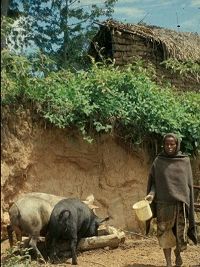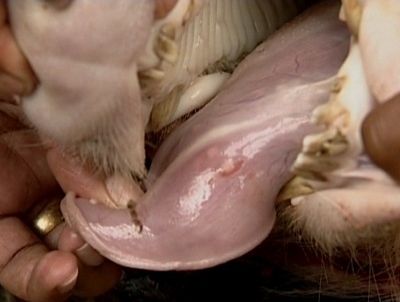The disease, though not endemic, is a serious medical problem in the U.S. causing more hospitalizations and hospital costs than malaria and rabies
Cysticercosis, an infection caused by the zoonotic pork tapeworm Taenia solium, occurs worldwide but more common in Latin America, SubSaharan Africa and South and Southeast Asia. According to the World Health Organization (WHO), “More than 1 billion people – a sixth of the world’s population – suffer from one or more neglected tropical diseases.” Additionally, WHO and the Food and Agriculture Organization (FAO) have ranked Cysticercosis as the world’s most serious food-borne parasitic disease.
The disease occurs where pigs range freely, sanitation is poor and meat inspection is absent or inadequate. Thus, it is strongly associated with poverty and smallholder farming. However, immigration of infected persons from endemic areas has resulted in increased incidence of cysticercosis in developed countries. In the U.S., for example, both the number of hospitalizations and hospital costs resulting from cysticercosis are greater than those resulting from malaria and other neglected tropical diseases combined. In the U.S., cysticercosis is now considered one of the Neglected Parasitic Infections (NPIs), a group of five parasitic diseases that have been targeted by the U.S. Centers for Disease Control and Prevention (CDC) for public health action.

Cysticercosis occurs in rural areas of developing countries
Cysticercosis is caused by the larval cyst form of Taenia solium, a zoonotic tapeworm transmitted between humans and pigs. When humans eat raw or undercooked infected pork containing the larvae, the adult tapeworm develops in the small intestine, a condition known as taeniasis (tapeworm infection). Pigs and humans can acquire the larval cyst form of the infection, called cysticercosis, when ingesting T. solium eggs that are passed in the feces of a human tapeworm carrier directly or through indirect contamination of food, water or the environment, such as in areas where human open defecation occurs. The parasitic larvae then inhabit muscles, subcutaneous tissues, eyes and the brain causing cysticercosis.
Someone with cysticercosis cannot transmit the disease to other people. Conversely, people with taeniasis may transfer tapeworm eggs to other people as well as pigs if they do not practice good hygiene or have limited resources to do so.
Cysticercosis can lead to epilepsy and even death in humans. Neurocysticercosis occurs when T. solium cysts occur in the brain. It is one of the most common parasitic infections of the human nervous system and considered the most frequent preventable cause of epilepsy in the developing world. It is responsible for approximately 30% of the acquired epilepsy cases in endemic countries, according to the World Health Organization.
Symptoms of neurocysticercosis depend upon the number, size and location of the cysts in the brain. Seizures and severe headaches are the most common symptoms. However, confusion, dementia, loss of balance, hydrocephalus, stroke and death may also occur. The WHO estimates that more than 80% of the world’s 50 million people affected by epilepsy live in developing countries, many of which are endemic for T. solium infections in people and pigs.
Cysticercosis has a significant impact on the agricultural systems of pig-producing communities, being responsible for poor pork quality and reduced value of pig carcasses, thereby reducing farmers’ income and making an important source of protein unsafe to consume. Pig traders, aware of the disease, may detect infection during a pre-purchase examination and then refuse to buy a suspect pig or offer a lower price. Farms and whole communities may become stigmatized when they are known to sell infected pigs and pork-containing cysts.

Pig traders can check the tongues of pigs to look for Taenia solium cysts before purchase
Although declared eradicable cysticercosis remains neglected in most endemic countries due to lack of information and awareness, diagnostic limitations, and lack of effective and sustainable prevention and control strategies. The latest WHO report on Neglected Tropical Diseases informs that although initiatives have been taken to scale up interventions, a 2015 goal of a validated control strategy has not been met. However, the largest hurdle in addressing cysticercosis may not actually be the lack of a validated control strategy, but simply the lack of awareness.
Intervention studies in Latin America funded by the Bill and Melinda Gates Foundation have provided evidence that transmission of cysticercosis and taeniasis can be interrupted in endemic developing countries. What is needed in the western hemisphere is a better understanding of the endemicity of T. solium infections, as the disease is not a problem throughout the entire hemisphere, but a subregional or even local one.
Many areas in Central America and the Caribbean basin are expected to be endemic for cysticercosis, as well as the source of the majority of infections recorded within the U.S. However, the studies that have been conducted are few in number and dated. Thus, the knowledge about where T. solium is present and how many people and pigs it affects is limited. Additionally in an April 2017 report, the WHO identified the lack of a regional network as a hurdle for T. solium control and elimination. Improvements in thus are essential if local governments are to effectively address this problem.
To reduce the burden of neglected tropical diseases on marginalized populations in low-resource areas, Ross University School of Veterinary Medicine (Ross Vet) in St. Kitts, West Indies, has taken an initiative to address the lack of Cysticercosis research conducted in Central America and the Caribbean. With a global approach to health, especially on diseases at the human-animal interface, Ross Vet sees this initiative as an important opportunity to reduce the burden of zoonotic diseases because many animal-related discoveries have human health implications. Ross Vet is establishing a regional network where researchers can share knowledge and practices relating to T. solium. The goal is to develop a One Health, transdisciplinary approach to undertake an analysis of the Cysticercosis problem in Central America and the Caribbean basin. Ross Vet aims to implement studies across the region to map parasite distribution and estimate disease burden as essential steps towards prevention.
